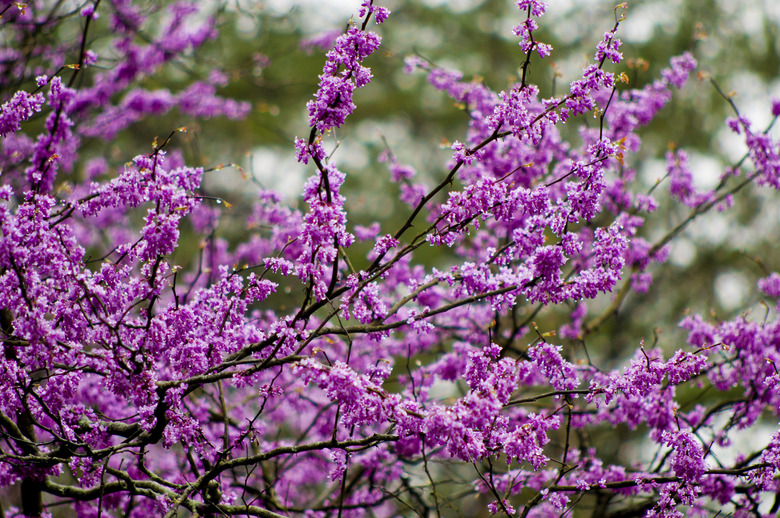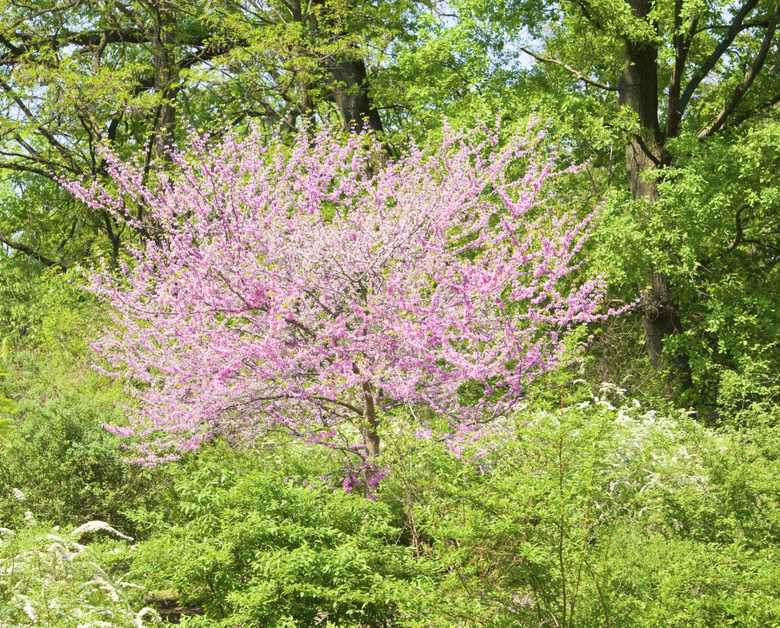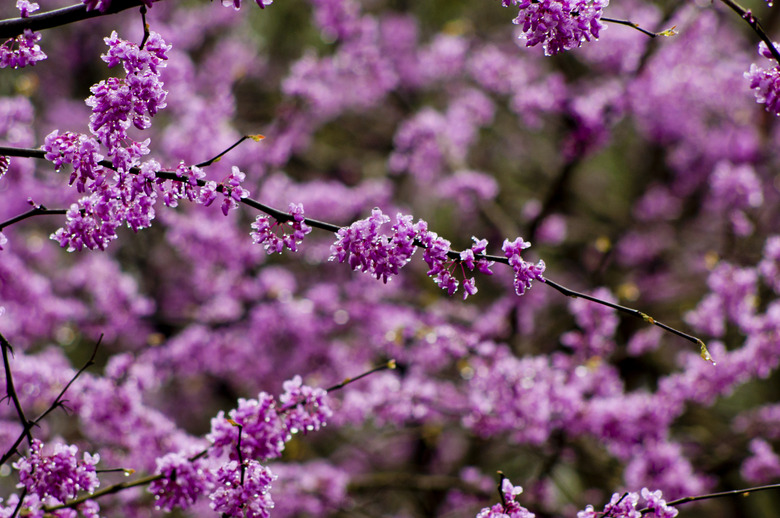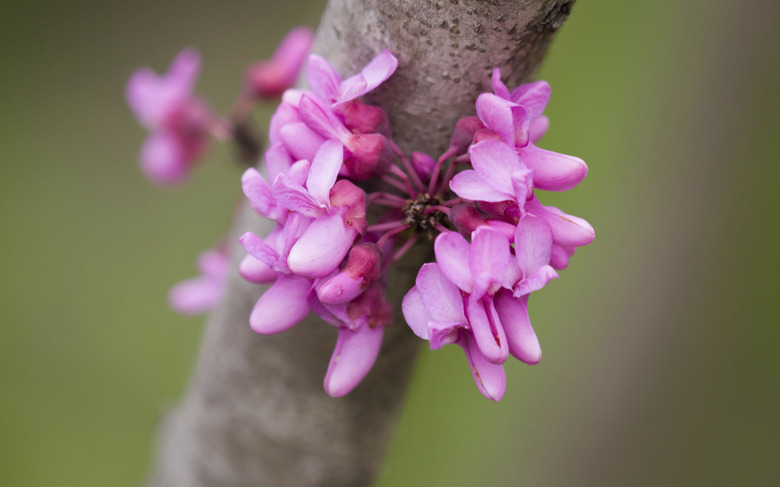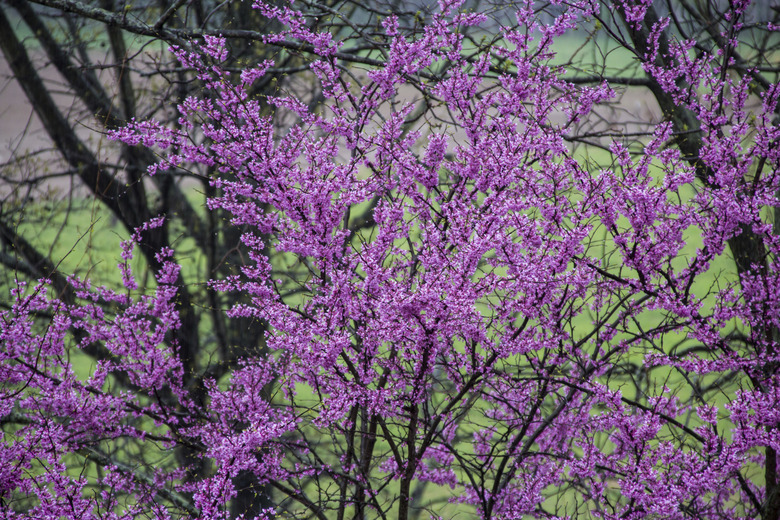How Big Do Redbud Trees Get?
Most redbuds are native trees that display colorful pink to light purple blossoms in spring and usually have multiple trunks. Native trees are typically easy to maintain, especially if you cultivate one that grows naturally in your area. The size of a redbud depends on whether or not it is a species, a subspecies or a hybrid tree. Some redbuds are moderately large trees, while some hybrids are hardly larger than shrubs.
Eastern and Western Redbuds
The native Eastern redbud (Cercis canadensis) is a multi-trunked tree that yields pink blossoms in April and grows from 20 to 30 feet high and 25 to 35 feet wide. It grows naturally in numerous areas of the Midwest and Northeast, and is hardy in U.S. Department of Agriculture plant hardiness zones 4 through 8.
Western redbud (Cercis occidentalis), sometimes called California redbud and listed as Cercis orbiculata, is a multi-trunked native tree found in many Western states. It grows from 12 to 20 feet high at the rate of 24 to 36 inches a year, yielding showy purple flowers in spring. It grows in USDA zones 7 through 9.
- Most redbuds are native trees that display colorful pink to light purple blossoms in spring and usually have multiple trunks.
- The native Eastern redbud (Cercis canadensis) is a multi-trunked tree that yields pink blossoms in April and grows from 20 to 30 feet high and 25 to 35 feet wide.
Southwestern Redbud Subspecies
A "var." in a scientific name indicates a named subspecies — a naturally occurring variant of the species. Two main variants of eastern redbuds grow naturally in the southwest.
A large, multi-trunk shrub or small tree, Mexican redbud (Cercis canadensis var. mexicana) grows from 10 to 15 feet high and 10 to 15 feet wide. It grows small, flat seed pods and yields rose-purple flowers in spring. It will grow in USDA zones 6a through 9a.
- in a scientific name indicates a named subspecies — a naturally occurring variant of the species.
- It will grow in USDA zones 6a through 9a.
Texas redbud (Cercis canadensis var. texensis) grows 15 to 20 feet high and 15 to 20 feet wide, yielding magenta to pink flowers in spring. It will grow in USDA zones 6a through 9.
Asian Redbuds
Chinese redbud (Cercis chinensis), native to China and Asia, grow 8 to 15 feet tall, has rosy, purple flowers and multiple trunks. It grows in USDA zones 6 through 9.
Also native to China, Giant redbud (Cercis gigantea) has glossy, dark green leaves from 6 to 8 inches wide and grows from 15 to 20 feet tall. It's hardy in USDA zones 7 through 8.
- Texas redbud (Cercis canadensis var.
- Also native to China, Giant redbud (Cercis gigantea) has glossy, dark green leaves from 6 to 8 inches wide and grows from 15 to 20 feet tall.
Hybrid Cultivars
Hybrid cultivars have the same USDA growing zones as their species or subspecies, so Cercis canadensis hybrids grow in USDA zones 4 through 8, and Cercis canadensis var. texensis hybrids grow in USDA zones 6a through 9.
"Ace of Hearts" (Cercis canadensis "Ace of Hearts") is similar to Eastern redbud, except it only grows 12 tall and has pinker flowers.
Showing lavender pink flowers, "Hearts of Gold" (Cercis canadensis "Hearts of Gold") has intense golden yellow foliage in spring and grows up to 15 feet tall.
Slightly larger at 15 to 20 feet tall and often with multiple trunks, "Texas White" (Cercis canadensis var. texensis "Texas White") has white flowers and thick glossy leaves.
"Oklahoma" (Cercis canadensis var. texensis "Oklahoma") also grows from 15 to 20 feet tall, often with multiple trunks, and has pink flowers.
- Hybrid cultivars have the same USDA growing zones as their species or subspecies, so Cercis canadensis hybrids grow in USDA zones 4 through 8, and Cercis canadensis var.
- Ace of Hearts" (Cercis canadensis "Ace of Hearts") is similar to Eastern redbud, except it only grows 12 tall and has pinker flowers.
Coming in at just 5 feet tall "Traveler" (Cercis canadensis var. texensis "Traveler"), actually a shrub form, has weeping branches 5 to 12 feet wide with dark, glossy leaves and lavender-pink flowers.
References
- Sonoma County Master Gardeners: Cercis Occidentalis
- Missouri Botanical Garden: Circus Canadensis
- Cal Poly Urban Forest Eco-Systems Institute: Western Redbud Cercis Occidentalis
- Clemson University Cooperative Extension: Redbud
- U.S. Forest Service: Cercis Orbiculata
- Texas A&M University Extension: Mexican Rosebud
- Texas A&M University Extension: Circus Canadensis Var. Texens
- Missouri Botanical Garden: Chinensis
